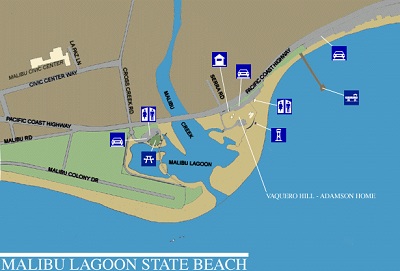MALIBU—The $7-million Malibu Lagoon restoration project received its final approval from the California Coastal Commission on the morning of Wednesday, October 13. Over 10 years in the making, the project is supported by conservation groups as a solution to polluted wetlands, stagnant water and overall poor ecological health. The main goal of the project is to restore Malibu lagoon’s ecosystem and function, while at the same time preserving and enhancing recreational activities.
The lagoon’s restoration is supported by conservation groups, such as Heal the Bay and Santa Monica Baykeeper, realizing the important opportunity to increase and restore tidal wetlands in Southern California. The lagoon’s current layout has water circulation problems and does not support a healthy ecosystem.
The project, which will improve water quality and biodiversity, will begin in the summer of 2011. The unanimous decision to approve the project means that the California State Department of Parks and Recreation will now proceed to temporarily drain a 12-acre portion of the lagoon.
In June 2011, crews will use bulldozers to grade the banks and re-shape the lagoon, which will create a single, clear channel for water flow. Over 1,000 dump-truck loads of sediment are expected to be removed and non-indigenous plants will be replaced with vegetation natural to a salt marsh. Pathways and walking bridges will also be removed to improve water movement.
Most opposition to the project revolved around the use of machinery to clear the area, arguing this method is too destructive to have a positive outcome. The Commission recommended approval of the restoration plan with 16 contingencies to ensure the project is completed with the utmost concern for environmental impact. The use of bulldozers and machines will allow the work to be completed in one season. This will help the lagoon recover naturally and sooner. The work has been specifically planned for the summer season, after consultation with the United States Fish and Wildlife Service, because summer is the most protective timeframe for the fish and animals living in the lagoon.
Sarah Sikich, coastal resources director of Heal the Bay, told Canyon News, “The approval of the restoration and enhancement project is a huge win for the Southern California Coast. This will benefit the aquatic life and surrounding environment.”
“Heal the Bay has historically done volunteer restoration,” says Sikich, but in the case of the Malibu lagoon, “the use of volunteers with shovels may take years to completely remove the sediment and restore the area. The use of machinery is for the best in this situation.” Sikich understands people’s concern regarding this project, but reassures this “restoration was largely planned by experts.”
The panel was motivated to approve the project by research from scientific studies and support from environmental groups. The California Department of Parks and Recreation began some restoration of the lagoon in 1983, when areas once used as baseball fields were cleared. Before that, the lagoon was used as a dump site by Cal Trans in the 1950s and 1960s.
Recently, the California State Coastal Conservancy, funded by a study by UCLA, identified problems with the ecological health and water quality and provided recommendations for a restoration plan. Heal the Bay, in cooperation with the California Department of Parks and Recreation and under a grant from the California State Coastal Conservancy, has coordinated the preparation of the restoration plan for the Malibu lagoon, which has been deteriorating because of human activity since the early 1900s.
The first phase of the restoration project began with the restoration of the existing parking lot. The water treatment parking lot, which captures, treats and infiltrates rainwater, officially opened in April. Over 3,000 native plants were introduced to the area. Other improvements include picnic and sitting areas, a new shower and an educational and interpretive center.






